

Swan Announces New Chief Investment Officer, Publishes Guide to Leveraged Bitcoin Equities
Ben Werkman joins Swan as CIO. New LBE primer explains key concepts, implementation steps, risk management, and valuation approaches.


While the outbreak of war is a stark reminder that the most precious things in life are nonmaterial, they simultaneously highlight the fact that global financial markets do not stop during times of conflict. In recent years, the escalation of geopolitical tensions, exemplified by conflicts in Eastern Europe and the Middle East, has underscored the persistent volatility facing the global markets.
In light of this, it is imperative for investors to remain vigilant—safeguarding assets, retirement portfolios, and children’s inheritances against the backdrop of heightened uncertainty. Now, more than ever, it is crucial that investors are strategically positioned to navigate through these turbulent times.
The question then arises: which asset allocations should investors consider during heightened geopolitical instability?
To address this question, an analytical review of historical performance data during similar times can offer invaluable insights. Although each conflict brings unique challenges and historical performance does not indicate future results, identifiable patterns in asset behavior during past conflicts can provide strategic guidance. This analysis aims to equip investors with the knowledge to make informed decisions about asset allocation that may preserve and potentially enhance wealth in today’s unpredictable environment.
Understanding the investment landscape in today’s volatile market requires a deep appreciation of the prevailing economic environment. Commonly, two economic patterns emerge prominently during wartime:
RM Increased government spending andC
BM Increased inflation
For example, consider the U.S. Civil War. Government spending increased to more than 30% debt-to-GDP at the height of the war.
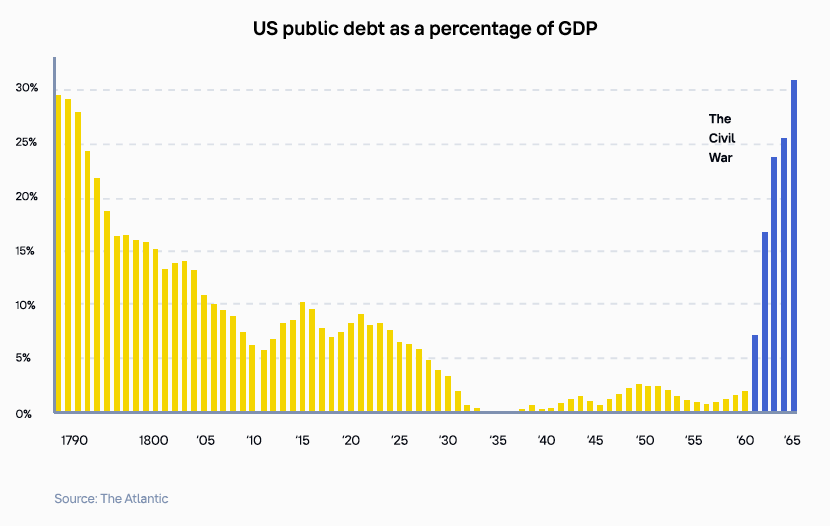
To put this spending into perspective, government debt stood at $65 million before the Civil War, but by the end of the war, it had exploded to $2.6 billion, a forty-fold increase.
This trend was echoed during World War II when government spending soared to more than 100% debt-to-GDP.
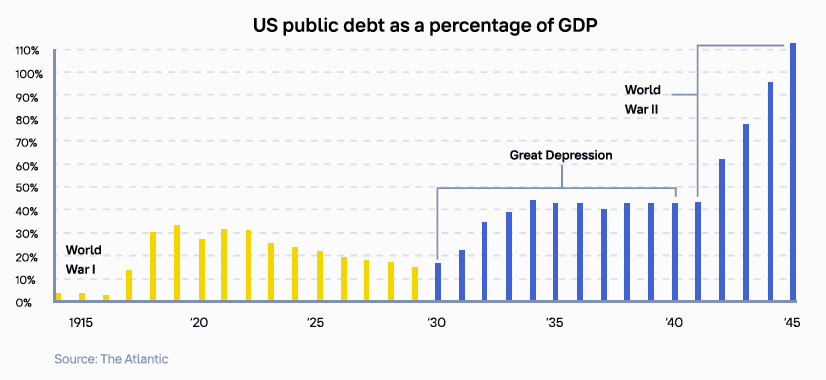
The national debt stood at $49 billion when the U.S. entered World War II. By the war’s end, the national debt stood at $259 billion. In other words, the national debt quintupled over the course of the war. One way to fathom this amount is that if an individual spent $1 million per hour, 24 hours per day, 365 days a year, it would take them 576 years to spend as much as the U.S. did during WWII! And back then, a million dollars was a fortune.
Such dramatic increases in government expenditure are not confined to the U.S.; historical data from the UK demonstrates similar spikes in defense spending as a percentage of GDP during major conflicts.

Notice in the chart above how spending as a percentage of GDP spikes with every major war conflict the UK has fought since 1692.
Governments typically pay for their expensive wars by a combination of printing money (devaluing their currency), borrowing money, or raising taxes.
Increased government spending is one reason why inflation is the other commonly observed economic feature in times of war. The chart below highlights how the U.S. CPI inflation rate has increased significantly around major wars throughout history.
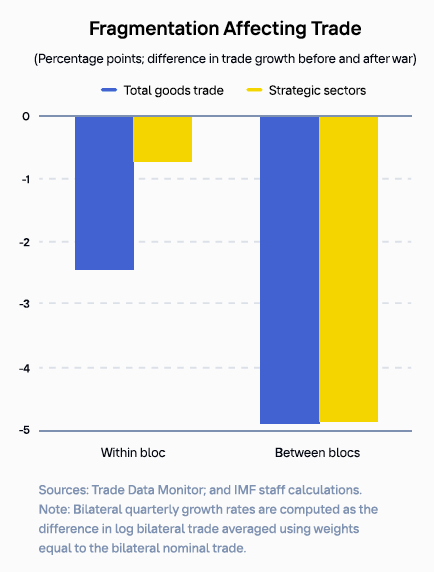
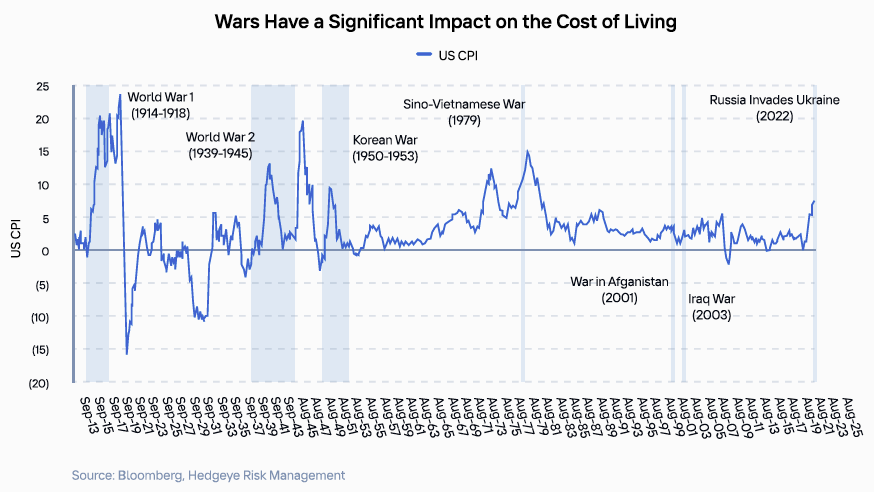
Outside of the increased government spending, war also leads to the fragmentation of global trade and disruptions in the global supply chain. This fragmentation raises the prices of items like oil, gasoline, food, and other commodities, which in turn causes more persistent inflationary pressures.
We are already seeing signs that trade fragmentation is well underway.
The IMF recently showed how fragmentation has negatively impacted world trade and income growth since Russia’s invasion of Ukraine.
Trade between economies in politically distant blocs has slowed more than trade between those within blocs since the start of the war. This has resulted in a significant slowing in the growth in goods traded between the two blocs since the start of the war compared to the growth in goods trade within blocs.
As we assess the economic landscape shaped by ongoing global conflicts, it’s evident that we may face sustained inflationary pressures similar to those observed in past wartime periods. This is driven by escalating government spending and disruptions in global supply chains, further intensified by the fiscal strains of recent years.
Since the onset of the pandemic, the U.S. recorded its highest deficits since WWII—15% of GDP in 2020 and 12.4% in 2021. In 2024, the deficit is on pace to exceed 6% debt-to-GDP, nearing the same level as the Global Financial Crisis. The trendline so far this century is unprecedented and alarming.
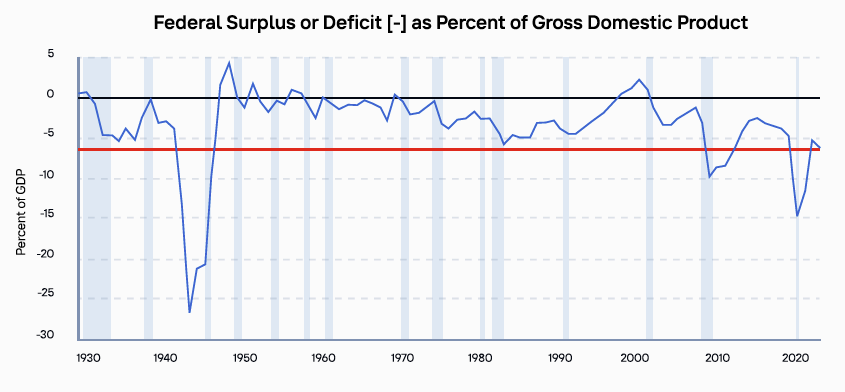
Looking ahead, the Congressional Budget Office (CBO) forecasts that the fiscal deficit will continue to rise, potentially reaching $2.6 trillion, or 6.1% of GDP, by 2034.
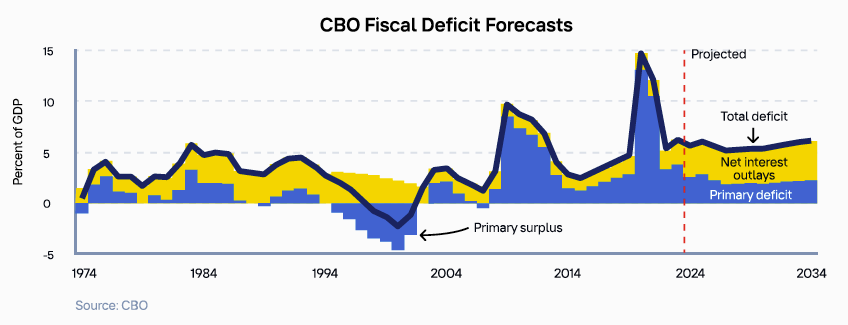
With inflation rates consistently surpassing the Federal Reserve’s target of 2% and no reduction in government expenditure on the horizon, the financial landscape is likely poised for persistent inflation.
Given these conditions and considering the severity of current international conflicts—a scale we have not seen in decades—it is crucial for investors to identify asset classes that have historically performed well under similar economic conditions. Let’s now take a closer look at what asset classes have proven effective in preserving and growing wealth during past periods of geopolitical unrest and inflation.
Although stocks are often considered a risk-on asset class, they have historically performed favorably in periods of conflict.
Analysis by Mark Ambruster, CFA, covering the period from 1926 to 2013, investigated how different asset classes performed during periods of war. His study found that U.S. large-cap stocks not only outperformed their long-term average returns during wars but also exhibited lower volatility while doing so.
During World War II, the Korean War, and the Gulf War, U.S. large-cap stocks rose by an average of 15.7%, outperforming the average annual return of 10% from 1926 to 2013. The volatility of U.S. large-cap stocks during those times was 12.8% compared to 19% during the whole time period.
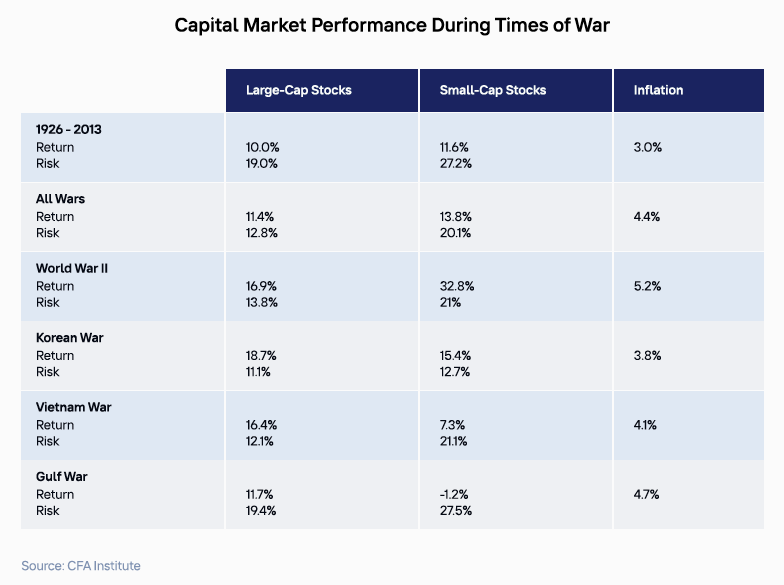
This unexpected resilience suggests that significant government spending during wars can boost domestic markets by enhancing company revenues and earnings despite the broader economic turmoil. It’s also worth noting that the stock market outperformed inflation in each of the wars shown above.
This is a key takeaway because, as previously discussed, elevated inflation is a common occurrence during periods of war due to increased spending, global supply chain disruptions, and rising commodity prices. Therefore, it’s important to invest in assets that will protect your wealth in real terms in a highly inflationary environment like war.
Furthermore, examining the initial market reactions to the last five major global conflicts reveals consistent patterns. Initially, investors typically react to the news of conflict with panic, leading to a market sell-off. However, the market then recovers within months and then exceeds previous highs within two years. This pattern is evident in five of the last six major global conflicts.
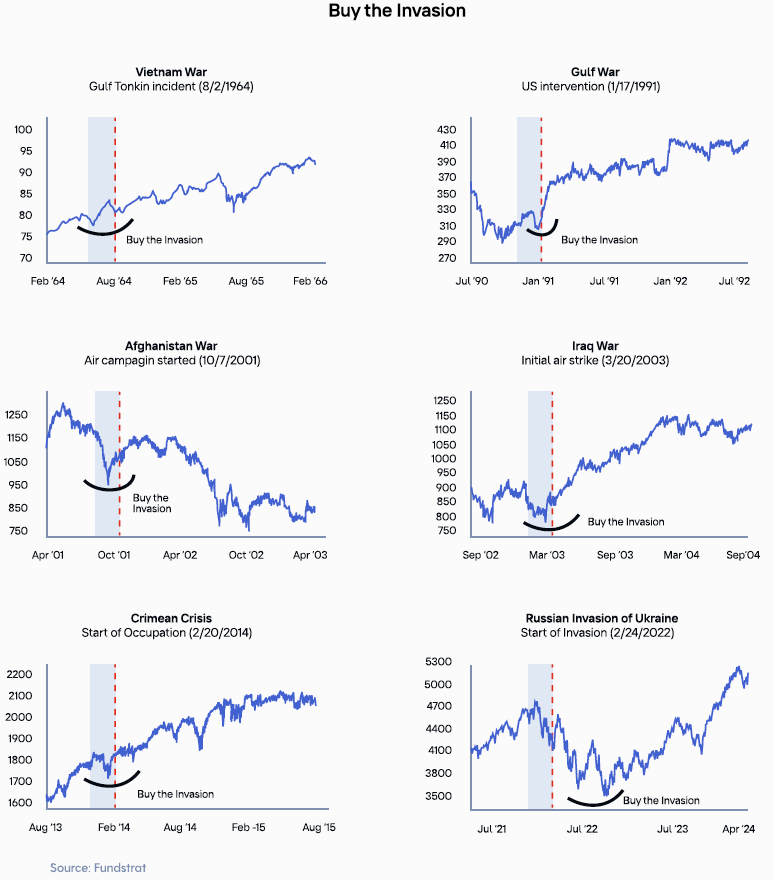
The Afghanistan War was the only outlier, which could be attributed to other factors related to the Dot-com Crash occurring around the same time as the start of the war.
This pattern held true with the recent Russian invasion too. Following the invasion, the stock market experienced a sharp decline. It then bottomed a few months afterward and went on to make new all-time highs about two years later.
This trend is again confirmed below when looking at more recent times of uncertainty. The stock market tends to drop on the news and then recover quickly.
According to Cetera Investment Management, the average 1-year S&P 500 return after some more recent crisis events was 13.16%, and the S&P 500 was positive in the year following each crisis event, with the exception being the 9/11 attacks.
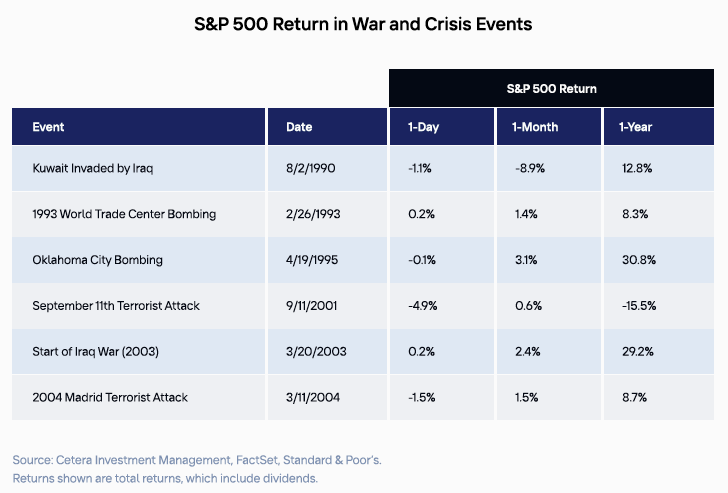
This historical resilience underscores the potential benefits of maintaining a well-diversified stock portfolio during times of war. It challenges the instinct to flee from equities in times of crisis, advocating instead for enduring short-term volatilities for long-term gains.
As we navigate this era of heightened conflict and economic instability, understanding these patterns and strategically positioning investments in light of them could help investors safeguard and potentially grow wealth in uncertain times.
Bonds are commonly regarded as a safe-haven asset; however, their performance during wartime suggests otherwise. During these periods, bonds tend to underperform relative to their long-term averages, primarily due to heightened inflation.
During wartime, governments significantly increase borrowing to fund military efforts, thereby flooding the market with debt and diluting bond values. This increase in government borrowing can raise doubts about a nation’s creditworthiness, pushing yields higher and bond prices downwards as a lure for investors.
Historically, there is a negative correlation between bonds and inflation. As inflation escalates, bond yields often increase with it, which in turn drives down bond prices.
When looking at historical periods when the U.S. experienced elevated inflation rates, the average real bond return was negative.
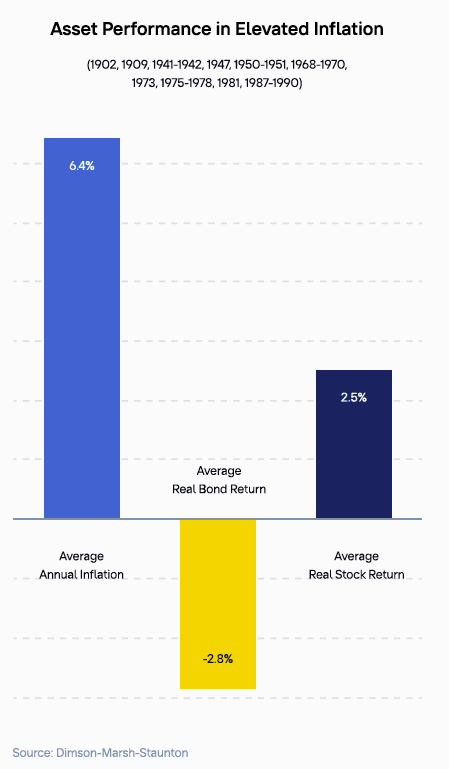
This trend continued in 2022 when CPI inflation hit multi-decade highs. The 10-year Treasury went on to have its worst performance in more than 200 years.
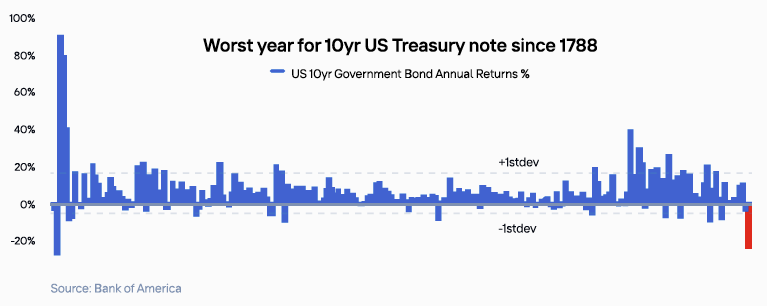
Periods of conflict present substantial inflation risk—also known as purchasing power risk to bondholders. Although bond investors will receive the full principal plus interest when their bonds mature, these returns often do not keep pace with inflation during times of war, diminishing the real value of the investment.
This is why bonds have performed poorly compared to their average performance in times of war historically.
According to the analysis from Mark Ambruster, CFA, bonds have lagged inflation and generated negative real returns in every major US war except the Gulf War.
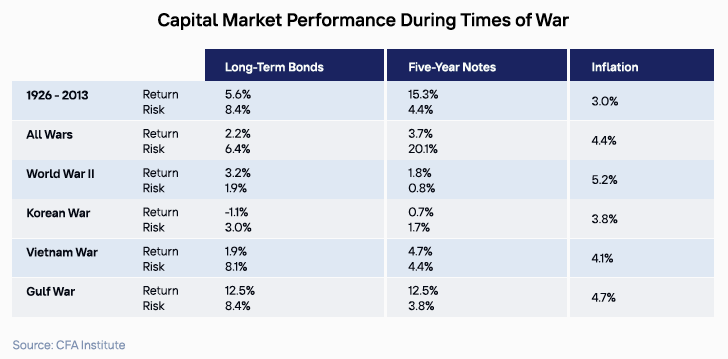
Bond performance during and after WWII provides a perfect example of bonds’ lackluster real returns during periods of war.
The chart below shows the nominal and real performance of bonds from 1941 to 1952.
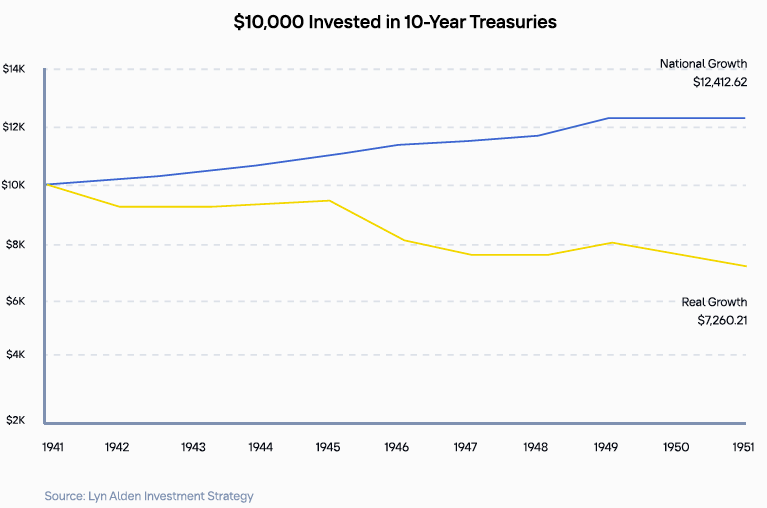
As you can see from the chart above, 10-year Treasury investors received all of their principal plus interest in nominal terms, but this was not nearly enough to keep up with the high rates of inflation during the war. As a result, 10-year Treasury bondholders lost nearly 30% of their purchasing power in the decade following 1942.
Bond investors were the big losers in WWII and the years afterward, underperforming nearly every other asset class between 1942 and 1952.
The combination of increased borrowing, rising rates, and inflation creates significant headwinds for bonds during times of war, which is why bonds typically underperform other asset classes.
Wars are expensive. As such, governments tend to spend heavily during times of conflict to fund the war effort. This surge in expenditure often leads to currency devaluation, which presents a significant risk for wealth stored in cash.
Under such circumstances, cash fails to keep pace with inflation and loses purchasing power. Simply put, the dollars that once afforded stability will inevitably decline in real value in a war-driven inflationary environment.
Warren Buffett succinctly captured this reality in an interview when he said,
“The one thing you could be quite sure of is if we went into some very major war, the value of money would go down. I mean, that’s happened in virtually every war that I’m aware of. So the last thing you’d want to do is hold money during a war.”
Given this reality, investors must consider more resilient alternatives to cash during times of heightened geopolitical unrest. Allocating to asset classes that traditionally outpace inflation can safeguard and potentially enhance wealth when currency values are pressured during times of conflict. This strategic shift is not just a safeguard but a proactive step towards ensuring that one’s savings maintain their purchasing power amidst the economic disruptions caused by war.
Gold is traditionally viewed as a safe haven asset that investors turn to during periods of heightened uncertainty and geopolitical tensions. It is particularly sought after due to gold’s status as a hard monetary asset—scarce and immune to the inflation risks that afflict fiat currencies. In times of war, when governments frequently resort to increased money printing and elevated spending, gold’s allure intensifies as a hedge against inflation.
Today’s environment is especially attractive for gold given the current sovereign debt levels. If governments have to ramp up their spending in response to rising geopolitical tensions, at a time when debt levels are already at historic highs, investors could become more worried about a potential debt crisis ensuing. In that scenario, demand for gold could accelerate as its lack of counterparty risk really shines.
An analysis of gold’s performance during various conflicts reveals a pattern: gold typically appreciates sharply at the onset of hostilities as investors flee to safety on the news. However, this spike is often temporary, as demonstrated by historical price corrections once the immediate uncertainties of conflict diminish.
Below is a chart of some major conflicts in the past with the gold’s 1-year return from the start of each crisis.
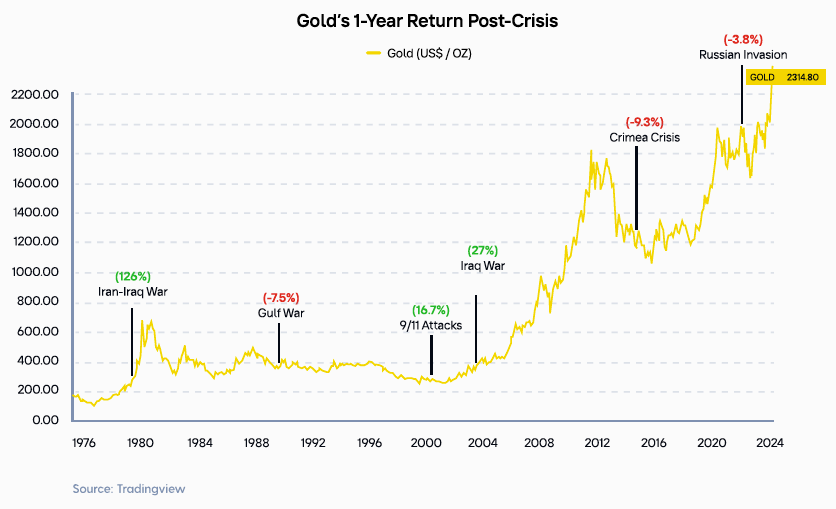
Investors appear to rush to gold at the height of panic and uncertainty when many unknowns remain. Yet after clarity comes into view about the nature of the crisis, on many occasions in history, the gold price falls back towards its pre-war price levels, and in some cases, even drops lower.
For instance, gold prices rallied 10% at the outbreak of the Gulf War, only to fall back below their pre-war price levels a year later when the war turned out to be less serious than originally expected.
Another example of this trend occurred with the recent Russian Invasion of Ukraine. Initially, gold rose about 5% in the week following the news, only to drop nearly 4% over the next 12 months.
Despite these fluctuations, gold tends to regain its appeal as the duration of heightened geopolitical risks lengthens. This resurgence is attributed to prolonged wars exacerbating inflationary pressures, leading governments to borrow extensively or debase their currencies. For example, since the escalation of the Russian invasion and rising tensions in the Middle East, gold prices have appreciated by 22%.
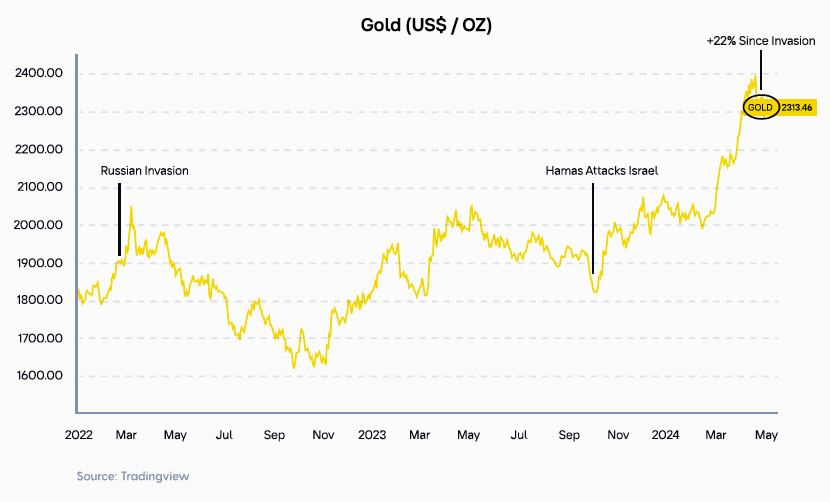
This performance underlines gold’s dual role: as a short-term safe haven reacting to immediate crisis-driven demand, and as a long-term store of value in the face of sustained geopolitical risks. Moreover, gold offers unique security advantages. Unlike stocks and bonds, physical gold held by investors incurs no counterparty risk. This attribute is particularly valuable in times of war, providing a level of security and control that stocks and bonds cannot match. However, investors should be cautious if gold is stored in third-party facilities, such as bank vaults, where it could be susceptible to theft or confiscation.
Overall, gold’s historical performance during wartime and its inherent monetary properties affirm its status as an effective hedge against inflation. These characteristics make it an appealing addition to well-diversified investment portfolios, especially during periods of prolonged geopolitical instability.
The recent developments in Eastern Europe and the Middle East have catapulted Bitcoin into the spotlight as a new safe haven for people to protect themselves against confiscation, censorship, and inflation during periods of increased geopolitical tensions.
This narrative came to the forefront when Western governments enforced sanctions against Russia after their invasion of Ukraine. As the banks closed, ATMs were drained, and payment firms like Visa and Mastercard shut down their operations, many Russian civilians turned to the only open-source monetary network available to them, Bitcoin, to transact with the outside world and flee their wartorn country with their wealth.
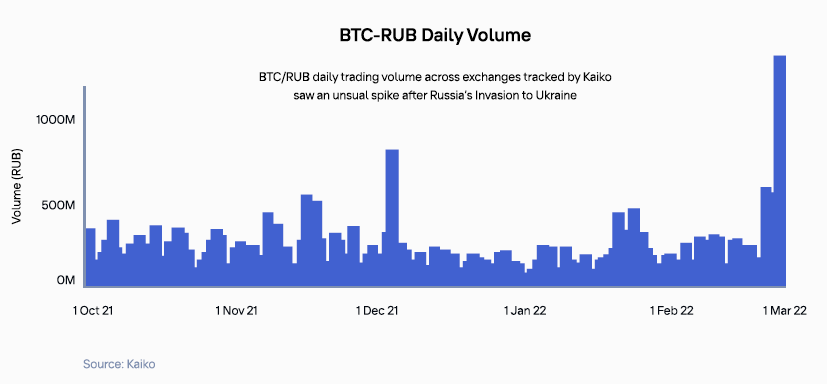
The same dynamics occurred on the other side of the battlefield as Ukrainians tried to flee the warzone with their wealth. In times of war, refugees typically have to leave places quickly with only what they can carry. Luckily for them, Bitcoin is highly portable and can be stored in one’s head if need be.
As a result, we saw Bitcoin trading volumes spike in Ukraine at the onset of the war. Bitcoin was trading at nearly a 10% premium on a number of Ukrainian exchanges against the Ukrainian hryvnia.
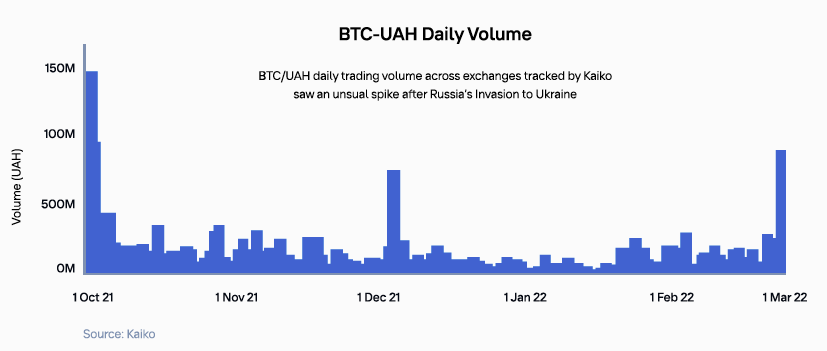
As geopolitical tensions intensified with the Russian invasion and escalating conflicts in the Middle East, Bitcoin exhibited significant price fluctuations. Initially, Bitcoin’s value surged over 10% in the week following the invasion, driven by heightened market anxiety. However, it then declined by 40% over the subsequent 12 months. Despite these fluctuations, as the geopolitical risks have persisted, Bitcoin’s demand has continued to rise, ultimately achieving a 68% appreciation and reaching new all-time highs.
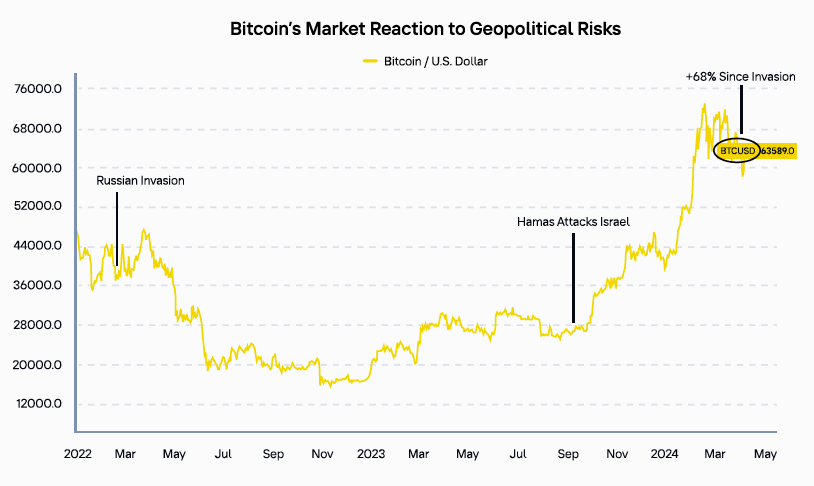
Since Bitcoin is a relatively young asset, the verdict is still out on whether it can serve as a safe haven asset in times of global conflict. To some, Bitcoin remains a volatile risk-on asset, while for others, it acts as a lifeline to escape their war-torn countries.
Unlike traditional asset classes, Bitcoin does not have the historical track record showing how it could perform in response to rising geopolitical conflicts. While it is still considered a relatively young and volatile asset, the ongoing global uncertainty has increasingly positioned Bitcoin as a viable hedge against geopolitical risks. Recent academic research, including studies by Bouri et al. (2017, 2020) and Aysan et al. (2019), underscores Bitcoin’s growing relevance as a safe haven asset and an alternative in times when traditional financial systems fall short. Another recent study published by the IMF provided further evidence that increased Bitcoin activity occurs as investors move away from risk assets, indicating that Bitcoin is being used by investors to hedge global uncertainty.
Often labeled as “digital gold”, Bitcoin shares many attributes with traditional safe havens but with some added advantages pertinent to wartime conditions. It has a fixed scarcity, is difficult to seize, and is easy to move because of its digital nature. These features are particularly appealing in inflationary wartime environments and help individuals to maintain financial autonomy in unstable regions. The current geopolitical climate presents a pivotal test for Bitcoin’s role as a reliable safe haven asset, resistant to inflation, confiscation, and censorship. Given its performance amid rising geopolitical tensions, investors should strongly consider the inclusion of Bitcoin in a well-diversified portfolio to mitigate risk and enhance returns.
Market responses to wartime and crises are notoriously difficult to predict and uncertain. Each conflict or crisis emerges under different market conditions, yet certain patterns consistently manifest. Notably, governments tend to ramp up spending, and global trade becomes fragmented, leading to sustained inflationary pressures.
Given the inflationary consequences of war, history advises caution regarding traditional safe-haven assets such as cash and bonds. These assets may not effectively preserve capital in such turbulent times. Investors are instead encouraged to diversify into assets that historically retain or increase in value during periods of inflation—gold, Bitcoin, and equities, for instance.
While it is critical to recognize that past performance is not indicative of future results, analyzing how these asset classes have reacted under similar conditions can provide valuable insights. The hope is this analysis will help the reader navigate today’s complex and uncertain financial landscape and make better-informed decisions to safeguard and potentially grow their wealth.
Buy automatically every day, week, or month, starting with as little as $10.
Sam Callahan is the Lead Analyst at Swan Bitcoin. He graduated from Indiana University with degrees in Biology and Physics before turning his attention towards the markets. He writes the popular “Running the Numbers” section in the monthly Swan Private Insight Report. Sam’s analysis is frequently shared across social media, and he’s been a guest on popular podcasts such as The Investor’s Podcast and the Stephan Livera Podcast.
News
More NewsThoughts on Bitcoin from the Swan team and friends.



By Swan Bitcoin
Ben Werkman joins Swan as CIO. New LBE primer explains key concepts, implementation steps, risk management, and valuation approaches.



By Cory Klippsten
Today we announce a new suite of security enhancements and elevated service tiers, reflecting our commitment to serving the Bitcoin-based investor.



By Jason Bassett
No longer a niche commodity, Bitcoin now finds itself a prime fixation of the US Executive Branch.